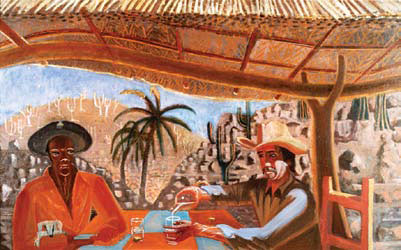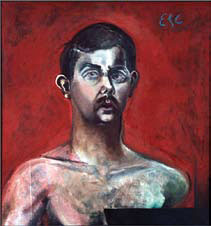![]()
September 9 – October 23, 2010
Curator's Statement
Deborah Kirklin
 Eduardo Carrillo is first and foremost a storyteller. His paintings tell us about the land of his grandmother, in Baja California, a piece of Carrillo’s Mexican American heritage. They tell us of history, mythology and spirituality, and of his keenly felt relationship to the history of European and Mexican painting. Carrillo’s paintings are narratives of human cooperation and resistance, of workers and lovers, of family and friends. A Chicano artist, Eduardo Carrillo had a bicultural perspective. He loved European painting, yet he created a forty-four foot long ceramic mural in Los Angeles called “El Grito” that commemorated the Mexican revolt against Spain in 1810.
Eduardo Carrillo is first and foremost a storyteller. His paintings tell us about the land of his grandmother, in Baja California, a piece of Carrillo’s Mexican American heritage. They tell us of history, mythology and spirituality, and of his keenly felt relationship to the history of European and Mexican painting. Carrillo’s paintings are narratives of human cooperation and resistance, of workers and lovers, of family and friends. A Chicano artist, Eduardo Carrillo had a bicultural perspective. He loved European painting, yet he created a forty-four foot long ceramic mural in Los Angeles called “El Grito” that commemorated the Mexican revolt against Spain in 1810.
Eduardo Carrillo was born in 1937 in Santa Monica, California, and he died in 1997 in San Ignacio, Baja, California. He grew up in Los Angeles and attended community college (Los Angeles City College) before attending the University of California at Los Angeles. There he studied art with William Brice and earned his Bachelor of Arts and Master of Arts degrees in 1962 and 1964 respectively. Following his years at U.C.L.A., Eduardo traveled to Spain to study and paint from the masters in the Prado Museum. Carrillo copied a painting by Hieronymus Bosch, using the traditional technique of oil glazes on wood panel. The eccentric Northern Renaissance painter had an influence on Carrillo’s choice of materials and on his imagination. Soon afterward, Carrillo’s paintings were being shown Ceeje Gallery in Los Angeles. Through the gallery, Eduardo encountered other artists who would become some of the most well known artists in L.A as well as life-long friends. His paintings from the early 1960s show the influence of the Spanish masters: Velazquez, Sanchez de Cotan, and Zurburan. He honed a kind of magic realism in these paintings of still lives, landscapes and empty rooms.
In 1966, Carrillo founded El Centro de Arte Regional in La Paz, Baja California. He moved his family to Baja to live, and started a school to teach painting, weaving, and ceramics, thus restoring the traditional crafts of the area. He deepened his ties to the land where his grandmother was born, and made friends with the people who were to serve as models for his paintings for decades. Carrillo’s style evolved and he began to paint the human figure more and more. In 1972, he joined the art faculty at the University of California at Santa Cruz, where he was a professor until he died in 1997.
 Reading the stories in Carrillo’s paintings requires the viewer to move back and forth between symbols of Mexican indigenous culture, references to European culture, and Carrillo’s personal history. For example, “Reaching for Coatlique” represents a contemporary man reaching for a woman laying across a skirt of writhing snakes, her shoulders covered by a serpent. In Aztec mythology, Coatlicue, whose name means “Serpent Skirt”, was the mother of the sun, moon and stars, the earth mother, the one who was the source of all life on earth, and the one who took back the dead into her body. Another important work,” Cabin In The Sky”, makes a strong political statement about the history of the Mexican people. It depicts a beautifully rendered imaginary landscape, and the “cabin in the sky” is a Greek temple floating over a razed platform of earth in a desert. The foreground of the painting appears to be a ceremonial space, similar to an altar. Art historian Sybil Venegas, professor of art history at East Los Angeles College states, […]“Chicano art theory has been grounded in the discourse of cultural memory, the resurrection of history, identity and struggle. Affirmations of a cultural past are often presented in the sacred art forms of altars, milagros, nichos, cajas, ancient Mesoamerican icons, narrative installations and what really amounts to the visualization of a spiritual quest for identity from a colonized population.”(1) One wonders whether “Cabin In The Sky” is an image of Aztlan destroyed by the conquistadors.
Reading the stories in Carrillo’s paintings requires the viewer to move back and forth between symbols of Mexican indigenous culture, references to European culture, and Carrillo’s personal history. For example, “Reaching for Coatlique” represents a contemporary man reaching for a woman laying across a skirt of writhing snakes, her shoulders covered by a serpent. In Aztec mythology, Coatlicue, whose name means “Serpent Skirt”, was the mother of the sun, moon and stars, the earth mother, the one who was the source of all life on earth, and the one who took back the dead into her body. Another important work,” Cabin In The Sky”, makes a strong political statement about the history of the Mexican people. It depicts a beautifully rendered imaginary landscape, and the “cabin in the sky” is a Greek temple floating over a razed platform of earth in a desert. The foreground of the painting appears to be a ceremonial space, similar to an altar. Art historian Sybil Venegas, professor of art history at East Los Angeles College states, […]“Chicano art theory has been grounded in the discourse of cultural memory, the resurrection of history, identity and struggle. Affirmations of a cultural past are often presented in the sacred art forms of altars, milagros, nichos, cajas, ancient Mesoamerican icons, narrative installations and what really amounts to the visualization of a spiritual quest for identity from a colonized population.”(1) One wonders whether “Cabin In The Sky” is an image of Aztlan destroyed by the conquistadors.
The Chicano Art Movement had its roots in the social activism of the 1960s. The civil rights movement as well as the women’s movement challenged American society to recognize the legitimacy of people who had typically lived at the political and economic margins of society. It was a literary, theatrical, artistic, and political movement dedicated to exploring indigenous cultural themes and political protest. Eduardo Carrillo’s activities in La Paz, and his mural commission El Grito, completed in 1979 for the city of Los Angeles, is a 44’ long ceramic tile mural at the Placita de Dolores depicting Father Miguel Hidalgo y Costillo, a Mexican Priest, leading an army in the fight for independence against Spain in 1810. Hidalgo’s cry, or grito, was a call for the end of slavery of the Mexican People.(2)
What makes Carrillo’s point of view different from the stance of many other Chicano painters, artists featured in “Chicano Visions: American Painters On The Verge”,(3) was that Carrillo’s paintings tend to refer to history, religion and mythology rather than the life of the street. Popular culture did not make a major appearance in his art. He did not paint images of the barrio, of men in zoot suits, police raids or car culture. Nor did the paintings contain explicit references to political leaders such as Dolores Huerta or Cesar Chavez. Eduardo’s paintings were also about the history of painting. He took up the universal themes: religion, death, love, and identity, and he made them personal.
While Carrillo continued to explore Chicano subject matter in his work, he also made intimate, personal paintings of landscape, still life and portraiture. His watercolors, painted constantly and from direct observation of daily life, represent a visual diary of the light, life and times of Eduardo. They exist for themselves and give us an insight into the artist’s drive to connect to the poetry of the everyday. Some of his most moving portraits are contained in this group of watercolor paintings. Carrillo’s watercolors and landscape paintings show the influence of Bonnard and Vuillard. The saturated blues and reds in the seascapes are reminiscent of the French fauves.
Carrillo’s second wife, Alison, provided Eduardo with the love and support that made his work during the late 1980s and 1990s so vibrant. She describes their life together and Carrillo’s painting routine in an interview in the exhibit catalogue. Although Eduardo died too soon, at age sixty, his time was rich. His paintings and murals endure, and his influence on his family, friends, students, and colleagues, and the wider community is still felt. This October the newly expanded Crocker Museum of Art in Sacramento is dedicating a gallery to the paintings of Eduardo Carrillo.
I would like to thank Alison Carrillo for her generosity in lending the art that made this exhibition possible, Juliette Carrillo for her loan of “Reaching For Coatlicue”, Helaine Glick at the Monterey Museum of Art for the loan of “Couple In The Garden”, and Joseph Chowning for the loan of “Jacopo and Tio Beto”. To Betsy Andersen of the Museo Eduardo Carrillo, whose assistance was crucial to the exhibition. For tireless hours installing and lighting the exhibition, many thanks go to Michael McGinnis, Exhibit Specialist. Thank you to Stephanie Sanchez, Eduardo’s friend and colleague and Robert F. Agrella Art Gallery Director, who contacted Alison Carrillo with our idea for the exhibition and assisted in all phases of the exhibition. Our thanks go to the SRJC Foundation for the Randolph Newman Cultural Enrichment Fund for the grant that made possible the printing of materials for the exhibit. To our Dean, Tyra Benoit, a huge thank you for the encouragement and support you gave to this endeavor.
Endnotes
- Los Cielos 2000: The Work of Linda Vallejo, critical essay by Sybil Venegas, Sept. 2000
- Peter Selz, Art of Engagement - Visual Politics in California and Beyond, University of California Press, San Jose Museum of Art, 2006
Cheech Marin, Chicano Visions American Painters On the Verge, Bullfinch Press, 2002